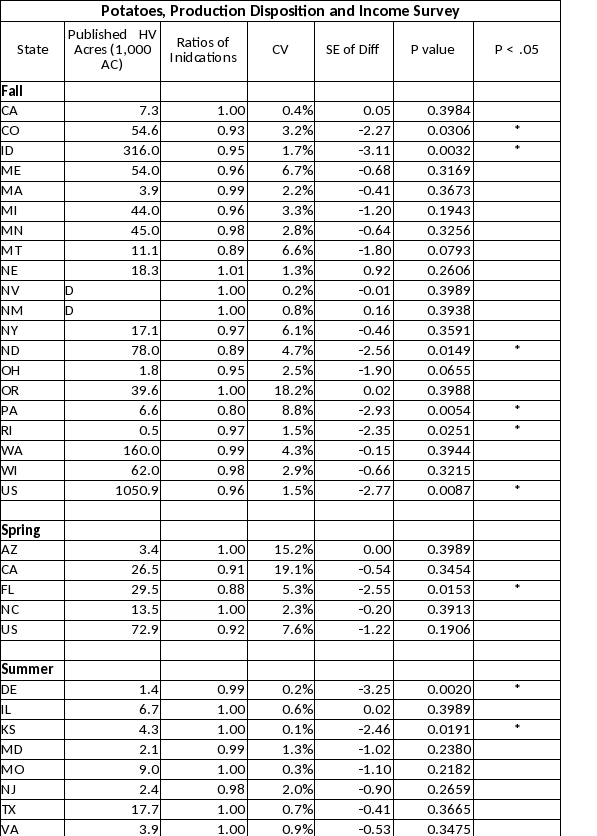Field Crops - Potato Bias Study
0002 - Field Crops - Potato Bias Study - July 2015.docx
Field Crops Production
Field Crops - Potato Bias Study
OMB: 0535-0002
Potato Bias Study
July 2015
NASS Methodology Division
Summary, Estimation, and Disclosure Methodology Branch
Jeff Bailey, Chief
Lindsay Drunasky, Section Head
Brent Farley, Team Member
There are three Potato Production Disposition and Income (PDI) surveys and all were below 80 percent response rate and averaged below 70 percent coverage so a nonresponse bias study was conducted for these. The method used was to match the non-respondents for the 2014 surveys to the 2012 Census of Agriculture and use the harvested acreage data as a proxy for the non-respondents. Of the total 899 non-respondents, 81.4 percent had a census match. The harvested acreage data will be off by 1-2 years depending on the survey, but should be a reasonable proxy. The survey expansions were recalculated with the census data used for the available non-respondents.
Results: The table 1 shows the results comparing the operational summary to the recalculated summary. The first column shows the published harvested acres. The second column shows the ratio of the operational summary to the recalculated summary. All but one state have ratios less than or equal to one telling us that the operational summary was less than the recalculated. Column 4 gives the CV for the operational summary and column 5 tells how many standard errors the recalculated summary is from the operational summary. The P values associated with the standard errors are given and those less the 0.05 are asterisked.
The results indicate that the operational summary is biased downward since almost all of the differences are in the downward direction and 9 of the states have P values less than 0.05. Additionally the US level is also down for two surveys and fall potatoes has a P value less than 0.05.
Discussion: The Potato PDI surveys have recently begun using the new standardized processes. The surveys now have the same questionnaire, Blaise editing tools, analysis system and summary methods. These changes will greatly improve the quality and consistency of the surveys. For each of the three surveys the CVs are relatively low since a large portion of the sample falls in probability one stratum which has no variance. Since the CVs are small, differences will quickly result in significant differences.
It should be noted that the PDI surveys are not the only source used to set the acreage numbers. Potato acreage is also collected on the Crops Acreage and Production Surveys (APS). These surveys have a multiple frame sample and have a much larger list sampling population. The Potato PDI population includes only those known to have potato acres and therefore does have under coverage. Since the Crops APS is the primary source used to set acreage estimates, official published numbers are less likely to be biased. The PDI surveys calculate ratios which are used for allocating the disposition and has a low risk of bias for the official published numbers.
The current nonresponse method is a simple reweighted estimator that calculates the expansion factor dividing the population by the number of usable responses within each strata. NASS will investigate alternative nonresponse adjustment methods to reduce the bias.

| File Type | application/vnd.openxmlformats-officedocument.wordprocessingml.document |
| Author | Bailey, Jeff - NASS |
| File Modified | 0000-00-00 |
| File Created | 2021-01-24 |
© 2026 OMB.report | Privacy Policy